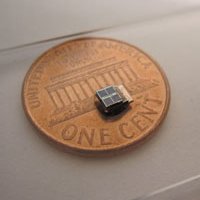
Posted on Sunday, March 07 2010 @ 6:00 CET by Thomas De Maesschalck
Researchers at the University of Michigan have developed a self-contained solar power system that measures just 9mm²:
A 9-cubic millimeter solar-powered sensor system developed at the University of Michigan is the smallest that can harvest energy from its surroundings to operate nearly perpetually.
The U-M system’s processor, solar cells, and battery are all contained in its tiny frame, which measures 2.5 by 3.5 by 1 millimeters. It is 1,000 times smaller than comparable commercial counterparts.
The system could enable new biomedical implants as well as home-, building- and bridge-monitoring devices. It could vastly improve the efficiency and cost of current environmental sensor networks designed to detect movement or track air and water quality.
With an industry-standard ARM Cortex-M3 processor, the system contains the lowest-powered commercial-class microcontroller. It uses about 2,000 times less power in sleep mode than its most energy-efficient counterpart on the market today.
The engineers say successful use of an ARM processor— the industry’s most popular 32-bit processor architecture—is an important step toward commercial adoption of this technology.
More info
over here.
